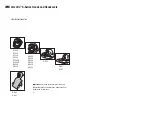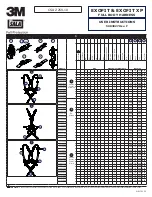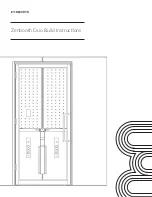
Code: 16-2093
3
www.ibiza-light.com
•
Avoid direct eye exposure to the light source while it is on as sensitive persons may suffer an epileptic shock
(especially meant for epileptics)!.
•
The product is for decorative purposes only and not suitable as a household room illumination.
•
If the external flexible cable or cord of this luminaire is damaged, it shall be exclusively replaced by the manu-
facturer or his service agent or a similar qualified person in order to avoid a hazard.
•
The light source of this luminaire is not replaceable. When it reaches the end of its life time, the whole unit
must be discarded.
FUSE REPLACEMENT
Locate and remove the unit’s power cord. Once the cord has been removed located the fuse holder located
inside the power socket. Insert a flat-head screw driver into the power socket and gently pry out the fuse holder.
Remove the bad fuse and replace with a new one.
Warning
: If after replacing the fuse you continue to blow fuses, STOP using the unit. Contact customer support
for further instructions. Continuing to use the unit may cause serious damage.
INSTALLATION
The unit should be mounted via its screw holes on the bracket. Always ensure that the unit is firmly fixed to
avoid vibration and slipping while operating. Always ensure that the structure to which you are attaching the unit
is secure and able to support a weight of 10 times of the unit’s weight. Also always use a safety cable that can
hold 12 times the weight of the unit when installing the fixture.
The equipment must be fixed by professionals at a place where is out of the reach of people and where nobody
can pass by or under it.
FIXTURE LINKING
You will need a serial data link to run light shows of one or more fixtures using a DMX-512 controller or to run
synchronized shows on two or more fixtures set to a master/slave operating mode. The combined number of
channels required by all fixtures on a serial data link determines the number of fixtures that the data link can
support.
CABLE CONNECTORS
Cabling must have a male XLR connector on one end and a female XLR connector on the other end.
DMX CONNECTOR CONFIGURATION
Termination reduces signal errors. To avoid signal transmission problems and interfe-
rence, it is always advisable to connect a DMX signal terminator.
CAUTION
Do not allow contact between the common and the fixture’s chassis ground. Groun-
ding the common can cause a ground loop, and your fixture may perform erratically.
Test cables with an ohm meter to check correct polarity and to make sure the pins
are not grounded or shorted to the shield or each other.
SETTING UP A DMX SERIAL DATA LINK
1. Connect the (male) 3 pin connector side of the DMX cable to the output (female) 3 pin connector of the
controller.
2. Connect the end of the cable coming from the controller which will have a (female) 3 pin connector to the
input connector of the next fixture consisting of a (male) 3 pin connector.
3. Then, proceed to connect from the output as stated above to the input of the following fixture and so on.
DMX ADDRESS SETTING
Each fixture must have a specific starting address. When receiving signal transmission, every fixture will receive
channels control signals for its own starting address.
The user can set several fixtures to the same address or set up a separate address for every device.
If more than one fixture is set to the same address, all of them receive the same DMX channels signals. All
connected fixtures are jointly controlled; the controller can’t control a device separately.
If every device is set to a different address, it will receive different DMX signals corresponding to its starting
address.
This device has 16 channels. So, the first device’s starting address is set 1, second is 17 (1+16), third is 33




































